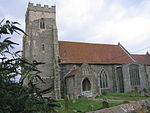Battle of Ringmere
The Battle of Ringmere was fought on 5 May 1010. Between an East Anglian contingent led by Ulfcytel Snillingr and a danish army under Thorkell the Tall Norse sagas recorded a battle at Hringmaraheiðr; Old English Hringmere-hǣð, modern name Ringmere Heath. In his Víkingarvísur, the poet Sigvat records the victory of Saint Olaf, fighting alongside King Ethelred Yet again Óláfr caused a sword-assembly [BATTLE] to be held for the seventh time in Ulfcytel’s land, as I recount the tale. The offspring of Ælla [= Englishmen] stood over all Ringmere Heath; there was slaying of the army there, where the guardian of Haraldr’s inheritance [= Óláfr] caused exertion. John of Worcester records that the Danes defeated the Saxons. Over a three-month period the Danes wasted East Anglia, burning Thetford and Cambridge.
Excerpt from the Wikipedia article Battle of Ringmere (License: CC BY-SA 3.0, Authors).Battle of Ringmere
East Wretham Road, Breckland District Wretham
Geographical coordinates (GPS) Address Nearby Places Show on map
Geographical coordinates (GPS)
| Latitude | Longitude |
|---|---|
| N 52.475 ° | E 0.825 ° |
Address
East Wretham Road
East Wretham Road
IP24 1FZ Breckland District, Wretham
England, United Kingdom
Open on Google Maps









